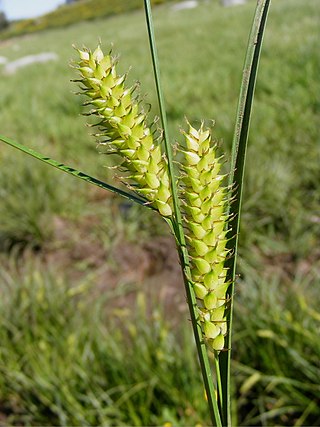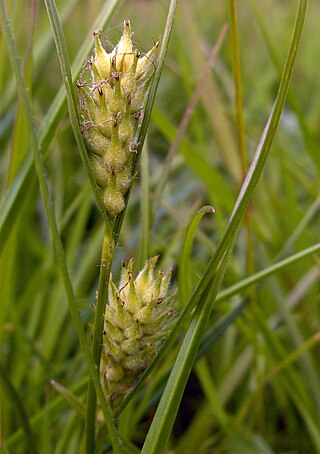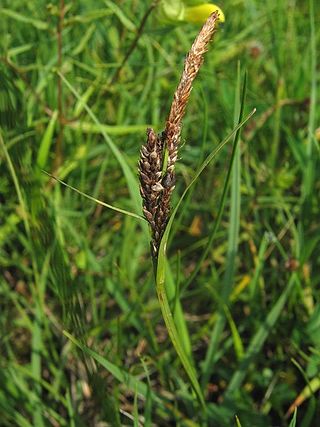
The Cyperaceae are a family of graminoid (grass-like), monocotyledonous flowering plants known as sedges. The family is large, with some 5,500 known species described in about 90 genera, the largest being the "true sedges" genus Carex with over 2,000 species.

Ornamental grasses are grasses grown as ornamental plants. Ornamental grasses are popular in many colder hardiness zones for their resilience to cold temperatures and aesthetic value throughout fall and winter seasons.

Carex is a vast genus of more than 2,000 species of grass-like plants in the family Cyperaceae, commonly known as sedges. Other members of the family Cyperaceae are also called sedges, however those of genus Carex may be called true sedges, and it is the most species-rich genus in the family. The study of Carex is known as caricology.

Campanula glomerata, known by the common names clustered bellflower or Dane's blood, is a species of flowering plant in the genus Campanula, belonging to the family Campanulaceae. It is the county flower of Rutland, England.

Ipomopsis aggregata is a species of biennial flowering plant in the phlox family (Polemoniaceae), commonly known as scarlet trumpet, scarlet gilia, or skyrocket because of its scarlet red flowers with lobes curving back as if blown back by rocketing through the air.

Carex flacca, with common names blue sedge, gray carex, glaucous sedge, or carnation-grass,, is a species of sedge native to parts of Europe and North Africa. It is frequent in a range of habitats, including grasslands, moorlands, exposed and disturbed soil, and the upper edges of salt marshes. It has naturalized in eastern North America.

Carex stricta is a species of sedge known by the common names upright sedge and tussock sedge. The plant grows in moist marshes, forests and alongside bodies of water. It grows up to 2 feet (0.61 m) tall and 2 feet (0.61 m) wide. When the leaves die, they build on top of or around the living plant, making a "tussock". Widely distributed in and east of the Great Plains, it is one of the most common wetland sedges in eastern North America.

Carex pendula is a large sedge of the genus Carex. It occurs in woodland, scrubland, hedges and beside streams, preferring damp, heavy clay soils. It is sometimes grown as a garden plant because of its distinctive appearance.

Carex vesicaria is an essentially Holarctic species of sedge known as bladder sedge, inflated sedge, and blister sedge. It has been used to insulate footwear in Norway and among the Sami people, and for basketry in North America.

Lindera aggregata is a plant species belonging to the genus Lindera.

John-Axel Nannfeldt, born 18 January 1904 in Trelleborg and deceased 4 November 1985 in Uppsala, was a Swedish botanist and mycologist.

Eucalyptus aggregata, commonly known as black gum, is a medium-sized tree that is endemic to southeastern Australia. It has rough, flaky bark, sometimes smooth on the branches, lance-shaped leaves, green to yellow flower buds in group of seven, white flowers and more or less cup-shaped fruit. It is a component of grassy woodland, often in low-lying or swampy areas, much of which has been cleared and it is under threat.
Kenneth Kent Mackenzie (1877–1934) was a lawyer and amateur botanist who wrote extensively on the genus Carex in North America. The standard author abbreviation Mack. is used to indicate this person as the author when citing a botanical name.

Carex hirta, the hairy sedge or hammer sedge, is a species of sedge native across Europe. It has characteristic hairy leaves and inflorescences, and is the type species of the genus Carex.
Aggregata is a genus of parasitic alveolates belonging to the phylum Apicomplexa.

Carex panicea, commonly known as carnation sedge, is a plant species in the sedge family, Cyperaceae. It is known as grass-like sedge and can be found in Northern and Western Europe, and also in north-eastern North America. The plant produces fruits which are 3–4 millimetres (0.12–0.16 in) long, are egg shaped and spiked. Both male and female species leaves are pale blue on both sides.

Carex viridula, known as little green sedge, green sedge, or greenish sedge, is a small flowering plant native to North America, Europe, Asia, and Morocco.

Carex bicolor, the bicoloured sedge, is a species of sedge native to North America, Northern Europe and Northern Asia. The International Union for Conservation of Nature has assessed the plant's conservation status as being of least concern because it has a widespread distribution and faces no particular threats.
















